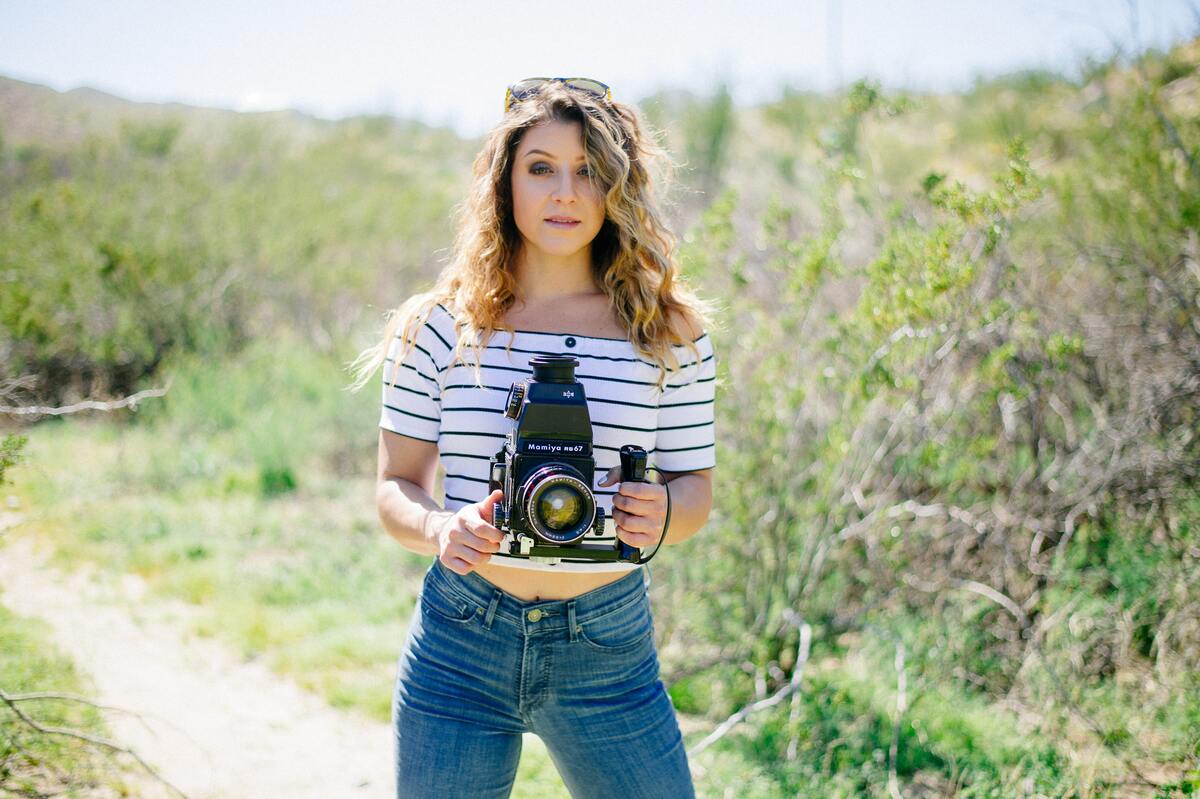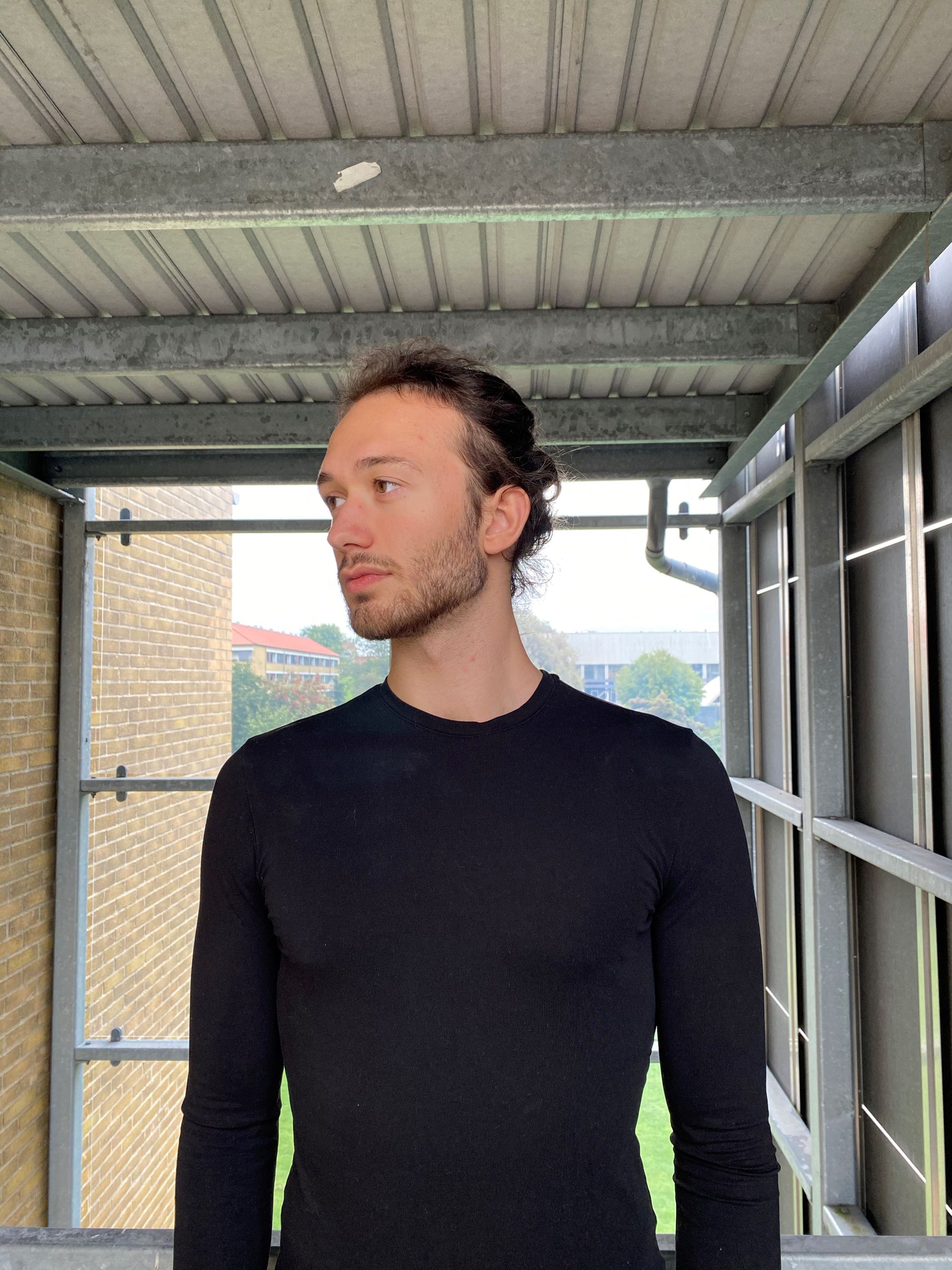Stunning Quality & Color – Here Are the 7 Best Medium Format Cameras
Rent film gear from local filmmakers.

Rent film gear from local filmmakers.
A medium format camera uses 120 film size or uses a digital imaging sensor, which is the same as its size.
They are known for being uncompromising on image quality and color reproduction. If this is what you’re looking for in a camera, read on for our top 7 picks.
The 7 best medium format cameras today
1. Fujifilm GFX 100s
Fujifilm always hits the nail on the head when packing a big sensor into a comparatively small body.
The dynamic range and image detail this thing is capable of are incredible- as well as its in-body image stabilization system and AF. This camera is smaller, lighter, and cheaper than any other camera offering 100MP right now.
Key features:
- 102MP BSI-CMOS 43.8x32.9mm medium format sensor.
- Lens mount: FujiFilm GF.
- Max continuous shooting speed: 5fps.
- Max video res: 4k at 30fps.
- 3.2” two-axis tilt touchscreen.
Pros:
- Dynamic range and image quality are beautiful.
- Classic and portable build.
Cons:
- Image stabilization system could be better.
- On the heavy side.
Who is this camera for? Professionals.

2. Fujifilm GFX 50S II
This is the fifth model in the highly successful GFX series, and it uses a lot of the landmarks of its predecessors.
Its body is comparatively more compact and the in-body image stabilization system has been taken up a notch- all for a more affordable price.
Key features:
- 51.4MP medium format sensor.
- Lens mount: FujiFilm G.
- Max continuous shooting speed: 3fps.
- Max video res: Full HD.
- 3.2” touchscreen.
Pros:
- Quite affordable.
- Beautiful image quality.
- Solid and ergonomic build.
Cons:
- No 4k video.
- On the heavy side- especially if held for a while.
- AF could use some work.
Who is this camera for? Professionals.
3. Hasselblad X1D II 50C
This minimal camera does not compromise on lens or image quality. It is on the expensive side, but if you want a camera that is beautiful to handle and to look at, this is the one for you.
Key features:
- 50MP medium format sensor.
- Lens Mount: Hasselblad X.
- Max continuous shooting speed: 2.7fps.
- Max video res: 2.7k.
- 3.6” touchscreen.
Pros:
- The detail on images is second to none.
- Robust build- surprisingly lightweight.
- Improved EVF and rear screen.
Cons:
- Contrast-based AF.
Who is this camera for? Professionals.
4. Fujifilm GFX 100
This camera is expensive compared to regular cameras, but in the world of medium format, it’s a bargain! Its 100MP resolution, hybrid AF, and in-body stabilization system are revolutionary for medium formats.
Key features:
- 102MP medium format sensor.
- Lens Mount: FujiFilm G.
- Max continuous shooting speed: 5fps.
- Max video res: 4k at 30fps.
- 3.2” touchscreen.
Pros:
- Full-frame 4k video.
- Has incredible resolving power.
Cons:
- An in-body stabilization system isn’t always reliable.
- Still expensive by average standards.
Who is this camera for? Professionals.

5. Pentax 645Z
This camera has a solid build- it’s weatherproof, easy to use, and on the affordable side. The image quality is still excellent by today’s standards, as is its AF system.
The only downside is that Pentax moves slowly, so you can never tell when lenses or upgrades will come out.
Key features:
- 51MP medium format sensor.
- Lens mount: Pentax 645AF2.
- Max continuous shooting speed: 3fps.
- Max video res: Full HD at 30fps.
- Viewfinder: Prism type.
Pros:
- Tilting Live View-enabled screen.
- Large sensor, with a big pixel count.
Cons:
- Heavy- weighs over 1.5kg without a lens!
- 5 years old.
Who is this camera for? Professionals.
6. Hasselblad H6D-100c
If you’ve ever wondered why Hasselblad gets loads of hype- try this camera to find out. Its image quality is second to none, as is the beautiful design- you can create unique images every time with this camera.
Key Features:
- 100MP medium format sensor.
- Can shoot up to ISO sensitivity of 12800.
- Burst rate: 1.5fps.
- Optical tilted viewfinder with an image magnification of 3.1x.
- Weighs over 2kg.
Pros:
- Excellent image quality and battery life.
- Weatherproof build.
- 4k recording.
- Intuitive controls and interface.
Cons:
- AF system and burst rate are only good for stills.
- No built-in flash unit.
- Expensive!
Who is this camera for? Professionals.

7. Leica S3
This camera is luxurious, and boy does its price tag reflect this. It’s essentially the size of a DSLR, but it has a 64MP sensor.
It promises 4K cinema-quality video capture with stereo sound, a maximum ISO sensitivity of ISO 50,000, and a Live View mode with a 60fps refresh rate. Sadly its heft price tag reserves this one for high-end users or Leica-enthusiasts.
Key features:
- 64MP medium format sensor.
- Lens Mount: Leica S.
- Max continuous shooting speed: 3fps.
- Max video res: 4k at 24fps.
- Pentaprism viewfinder with an illuminated LCD bar.
Pros:
- Splash and dust-resistant build.
- Very high resolution.
Cons:
- It costs $22,000!
- Burst shooting speed is modest.
Who is this camera for? Professionals.
Essential features in a medium format camera
1. Camera system
Medium format cameras come in several different types:
Twin lens reflex uses 2 lenses, one for the image and one for the viewfinder.
Rangefinder, which has more limited focus ranges.
Viewfinders, which are older and highly specialized.
SLRs are the most common and versatile of these varieties, making them ideal for most users.
2. Build design
An ideal medium format camera would be lightweight with high rigidity, precision, and durability. Most professional medium format cameras will be built to protect themselves from dust, dirt, etc.
Most DSLRs are made with a specialized magnesium alloy, which is light and comfortable. Always look carefully at the descriptions before you buy.
3. Processor and sensor
Sensors are essential when buying any camera since it is the key to image quality, low-light performance, the camera’s size, and much more. Medium format sensors tend to be in the 43 x 32mm and at least 50-megapixel range.
Most processors are brand-specific and proprietary- so look for processors current in their tech specs and up to date with comparable models.
What about the accessories you ask?
Check out our page on camera equipment to clue yourself up.

Rent or subscribe to a medium format camera
Eager to try a medium format camera for yourself? Head over to our website to rent or subscribe to a medium format camera.
Camera Hire: Take Your Production to The Next Level
71PttfqWPXk
Camera Rental: Save Money with Wedio
5sHshmF1n_Y
Rent Camera Gear: Access Pro Equipment
qqHXJy6AWlc
About the instructors
FAQ
Are medium format cameras better?
Medium format cameras often deliver much higher quality images than other cameras. They are built for versatility and specialized photography and are often the first port of call for professionals.
Are medium format cameras still used?
Yes! Especially by professionals and high-end users. It is the preferred format in commercial photography, too.
How do I choose the best medium format camera?
Choosing the best medium format camera will depend on your needs and wants. If you want some general guidance: look for one with a magnesium alloy build, a lightweight design, a fast processor with the highest specs available, and a sensor capable of capturing at least 50-megapixel 16-bit images with maximum color depth.






















